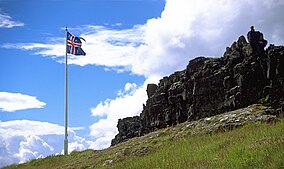
Þingvellir
Site of Iceland's ancient parliament / From Wikipedia, the free encyclopedia
Dear Wikiwand AI, let's keep it short by simply answering these key questions:
Can you list the top facts and stats about Þingvellir National Park?
Summarize this article for a 10 years old
Þingvellir (Icelandic: [ˈθiŋkˌvɛtlɪr̥] ⓘ, anglicised as Thingvellir[Note 1]) was the site of the Alþing, the annual parliament of Iceland from the year 930 until the last session held at Þingvellir in 1798.[2] Since 1881, the parliament has been located within Alþingishúsið in Reykjavík.[3]
| Þingvellir National Park | |
|---|---|
 Þingvellir seen from the information centre | |
 | |
| Area | 9,270 ha (35.8 sq mi) |
| Established | 1930 (1930)[1] |
| Official name | Þingvellir National Park |
| Location | Southern Region, Iceland |
| Criteria | Cultural: (iii), (vi) |
| Reference | 1152 |
| Inscription | 2004 (28th Session) |
| Endangered | lynx |
| Website | www |
| Coordinates | 64°15′13.7″N 21°2′14.1″W |
Þingvellir is now a national park in the municipality of Bláskógabyggð in southwestern Iceland, about 40 km (25 miles) northeast of Iceland's capital, Reykjavík. Þingvellir is a site of historical, cultural, and geological significance, and is one of the most popular tourist destinations in Iceland. The park lies in a rift valley that marks the crest of the Mid-Atlantic Ridge and the boundary between the North American and Eurasian tectonic plates. To its south lies Þingvallavatn, the largest natural lake in Iceland.[4]
Þingvellir National Park (þjóðgarðurinn á Þingvöllum [ˈθjouðˌkarðʏrɪn au ˈθ iŋkˌvœtlʏm]) was founded in 1930, marking the 1000th anniversary of the Althing. The park was later expanded to protect the diverse and natural phenomena in the surrounding area and was designated as a World Heritage Site in 2004.
